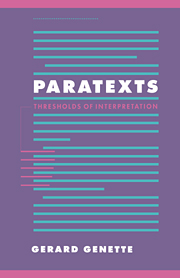Book contents
- Frontmatter
- Contents
- Foreword
- List of books by Gérard Genette
- Translator's note
- 1 Introduction
- 2 The publisher's peritext
- 3 The name of the author
- 4 Titles
- 5 The please-insert
- 6 Dedications and inscriptions
- 7 Epigraphs
- 8 The prefatorial situation of communication
- 9 The functions of the original preface
- 10 Other prefaces, other functions
- 11 Intertitles
- 12 Notes
- 13 The public epitext
- 14 The private epitext
- 15 Conclusion
- Additional references
- Index
12 - Notes
Published online by Cambridge University Press: 04 November 2009
- Frontmatter
- Contents
- Foreword
- List of books by Gérard Genette
- Translator's note
- 1 Introduction
- 2 The publisher's peritext
- 3 The name of the author
- 4 Titles
- 5 The please-insert
- 6 Dedications and inscriptions
- 7 Epigraphs
- 8 The prefatorial situation of communication
- 9 The functions of the original preface
- 10 Other prefaces, other functions
- 11 Intertitles
- 12 Notes
- 13 The public epitext
- 14 The private epitext
- 15 Conclusion
- Additional references
- Index
Summary
Too many notes!
Joseph IIWith notes we doubtless reach one – indeed, several – of the borders, or absences of borders, that surround the eminently transitional field of the paratext. Their strategic importance will perhaps offset the inevitably disappointing nature of a “genre” whose occurrences are by definition irregular, divided up, crumbly, not to say dustlike, and often so closely connected to a given detail of a given text that they have, as it were, no autonomous significance: hence our uneasiness in taking hold of them.
Definition, place, time
For the moment, I will give the note as formal a definition as possible, without broaching the subject of function. A note is a statement of variable length (one word is enough) connected to a more or less definite segment of text and either placed opposite or keyed to this segment. The always partial character of the text being referred to, and therefore the always local character of the statement conveyed in a note, seems to me the most distinctive formal feature of this paratextual element, a feature that contrasts the note with, among other paratexts, the preface – including those prefaces or postfaces that are modestly entitled “Note,” as Conrad's very often are. But the formal distinction between note and preface obviously reveals an affinity of function: in many cases, the discourse of the preface and that of the apparatus of notes are in a very close relation of continuity and homogeneity.
- Type
- Chapter
- Information
- ParatextsThresholds of Interpretation, pp. 319 - 343Publisher: Cambridge University PressPrint publication year: 1997



